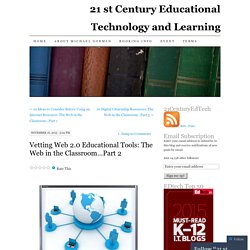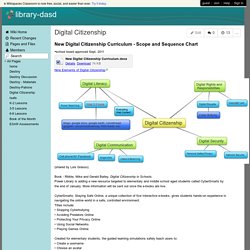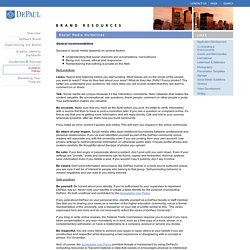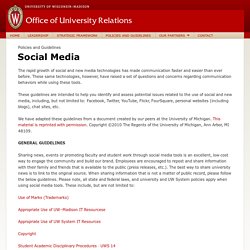

Buffer - A Smarter Way to Share on Social Media. Vetting Web 2.0 Educational Tools: The Web in the Classroom…Part 2. Welcome to another article in a series devoted to facilitating proper student internet interaction in the classroom.

This classroom might be 1 to 1 or might be using technology to leverage student centered learning. In this post I would like to explore steps to take and reflect on when vetting a Web 2.0 interactive tool for classroom use. Before reading, please take a moment to subscribe by email or RSS and also give me a follow on Twitter at mjgormans. I promise you will find some great information coming your way this school year…So Sign up now and please pass this on with a retweet! – Mike Gorman ( Booking Info – It is time to think about your school or conference needs. Upcoming Opportunities: Join me at PBS Learning Media on Monday, November 23 at 7 PM EST for a free webinar on learning about STEM and Ocean Life through the PBS program, Big Blue Live and numerous free internet resources.. Vetting Web 2.0 Educational Tools: The Web in the Classroom…Part 2. Privacy Policy Generator - TermsFeed.
Didn't Read Facebook's Fine Print? Here's Exactly What It Says. So, like every other one of the world's 1.28 billion monthly active Facebook users, you blindly agreed to Facebook's Terms and Conditions without reading the fine print.

You entrusted your photo albums, private messages and relationships to a website without reading its policies. And you do the same with every other site ... sound about right? In your defense, Carnegie Mellon researchers determined that it would take the average American 76 work days to read all the privacy policies they agreed to each year. So you're not avoiding the reading out of laziness; it's literally an act of job preservation.
So here are the Cliffs Notes of what you agreed to when you and Facebook entered into this contract. Nothing you do on Facebook is private. Note the rather vague use of the word "infer," which Oxford Dictionary defines as "Deduce or conclude (information) from evidence and reasoning rather than from explicit statements. " That includes some things you haven't even done yet. Library-dasd - Digital Citizenship. -school board approved Sept, 2011 Nine Elements of Digital Citizenship (shared by Lois Grasso) Book - Ribble, Mike and Gerald Bailey, Digital Citizenship in Schools.

Power Library is adding a new resource targeted to elementary and middle school aged students called CyberSmarts by the end of January. More information will be sent out once the e-books are live. CyberSmarts: Staying Safe Online, a unique collection of five Interactive e-books, gives students hands-on experience in navigating the online world in a safe, controlled environment.
Building and maintaining an online professional learning community. We’ve all been there.

You go to a workshop, excited to have a day away from school and eager to learn new ideas. Throughout the workshop, you explore new resources, see effective strategies being modeled, take notes, and flag pages to refer to once you get back to the classroom. You leave the workshop on a high, excited about what you’ve learned and rejuvenated from a day of professional learning and dialogue. You have high hopes of making instructional changes and using the new resources with your students, and you can’t wait to share what you’ve learned with the teacher down the hall. The following day, you return to your classroom, put your workshop materials on a shelf for the time being, and pick up where you left off two days ago.
PLCs: A lasting impact Even with the best intentions, many teachers never make any real change to their instruction based on what they learn in one-shot workshops. Creating a meaningful online professional learning community. Eduguide. The Educator’s Guide to Social Media. Click here for The Educator’s Guide to Social Media (PDF) The Educator’s Guide to Social Media explains how educators can use social media in class and in their personal and professional lives while enhancing — not risking — their professional reputation.

Press release about the guide If you’d like to reprint multiple copies, please click here. Safety advice for major social networking services: ConnectSafely ‘Parents’ guides to Instagram, Snapchat, Ask.fm, mobile phones, cybersecurity and cyberbullyingChildnet International safety resources for Instagram, Ask.fm, Snapchat, Facebook, Google+, Tumblr & Twitter, YouTube & more Help and advice when issues arise: Resources for Youth in Crisis (compiled by ConnectSafely)ICanHelpLine (right now just for schools in California)Cyberbullying Research Center Abuse report pages: Facebook Twitter LinkedIn YouTube Google+ Privacy setting pages: Facebook Google+ LinkedIn Twitter YouTube.
Social Media Policies in Higher Education. By Melissa Venable In a recent post I reviewed the results of EDUCAUSE's latest survey on students and technology in higher education.

Social-media-in-higher-education.pdf. Social Media Guidelines. General recommendations Success in social media depends on several factors: Understanding that social channels are conversations, not bullhorns Being civil, honest, ethical and responsive Remembering that nothing is private on the WebBest practices Listen.

Spend time listening before you start posting. What issues are on the minds of the people you want to reach? Talk. Be accurate. If you make an error, correct it quickly and visibly. Be aware of your impact. Be calm. Grand Valley State University. As an institution, Grand Valley recognizes the value of social media applications and supports their use.

Social media is a powerful communications tool that has a significant impact on organizational and professional reputations. Because social media blurs the line between personal voice and institutional voice, Grand Valley has crafted guidelines to help clarify how best to enhance and protect personal and professional reputations when participating in social media. Grand Valley maintains official pages on various social media platforms. You can find links to those pages at www.gvsu.edu/socialmedia. These pages are maintained for the purpose of reaching people and engaging them with the university and its services. Office of University Relations. The rapid growth of social and new media technologies has made communication faster and easier than ever before.

These same technologies, however, have raised a set of questions and concerns regarding communication behaviors while using these tools. These guidelines are intended to help you identify and assess potential issues related to the use of social and new media, including, but not limited to: Facebook, Twitter, YouTube, Flickr, FourSquare, personal websites (including blogs), chat sites, etc. We have adapted these guidelines from a document created by our peers at the University of Michigan. This material is reprinted with permission. Copyright ©2010 The Regents of the University of Michigan, Ann Arbor, MI 48109. Social_new_media_guidelines.pdf.